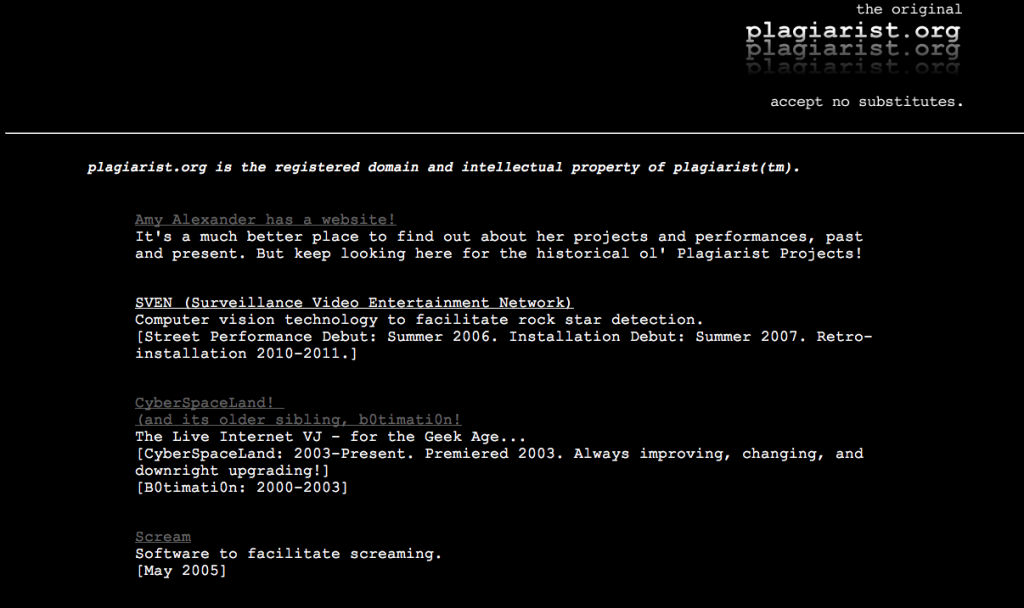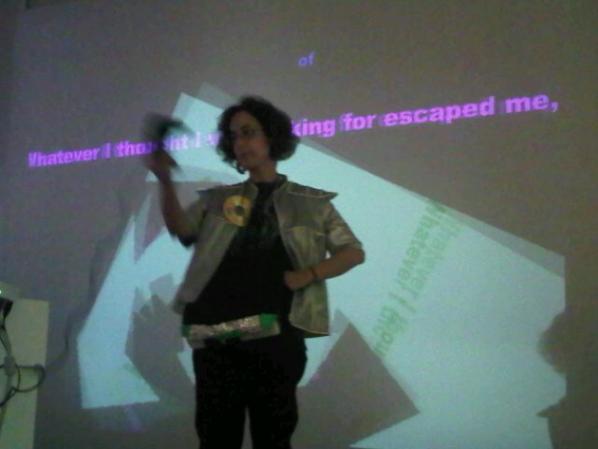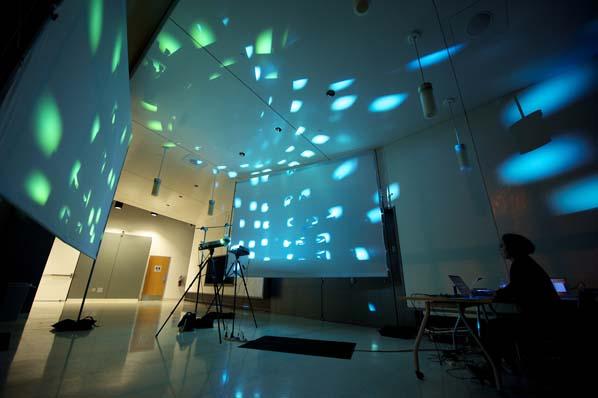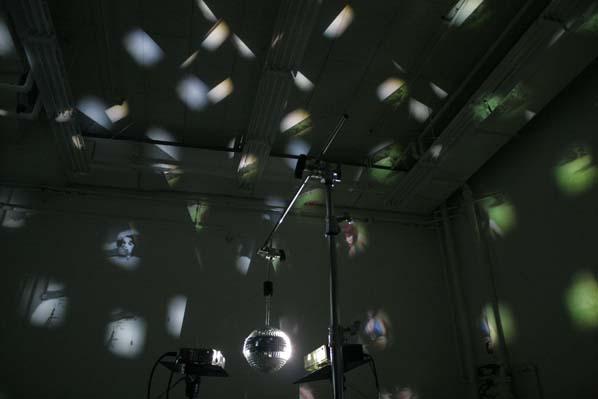



This conversation follows in a series of interviews with women who work at the intersection of art and technology. Amy Alexander’s work as an artist, performer, musician, and professorapproaches art and technology from a performing arts perspective, often examining intersections of art and popular culture.
Amy Alexander is an artist and researcher working in audiovisual performance and digital media art. She has worked under a number of pseudonyms including VJ Übergeek and Cue P. Doll. Coming from a background in film and music, she learned programming and began making time and process-based art on the Internet in the mid-1990’s with the Multi-Cultural Recycler and plagiarist.org. Amy has performed and exhibited on the Internet, in clubs and on the street as well as in festivals and museums. Her work has appeared at venues ranging from the Whitney Museum and Ars Electronica to Minneapolis‚ First Avenue nightclub. She has written and lectured on software art and audiovisual performance, and she has served as a reviewer for festivals and commissions for new media art and computer music. She is an Associate Professor of Visual Arts at the University of California, San Diego. During summer/fall of 2012, Amy is Artist-in-residence at iotaCenter in Los Angeles.
Rachel Beth Egenhoefer: You’ve taken on many roles as an artist, musician, performer, coder, organizer, professor. How would you explain what you do to the “average Joe” who has not idea what a code artist is?
Amy Alexander: I usually don’t try to explain to people what a code artist is. I generally just tell them about the types of projects I or my students do, (“museum installation,” “club performance,” etc.) and what some of them are about. Then I explain that it’s done by writing software, building electronics, making videos, etc. But the point is more about the projects, not about how specifically they are made.
I also think talking about code-as-art is both less necessary and less difficult than it was five or ten years ago. What motivated me and a lot of other code artists back then was a concern that algorithms had a cultural impact that wasn’t well-recognized. Nowadays, people are familiar with the idea that Google sorts your search results in a particular way, websites you visit develop demographic profiles of you, etc. – they’re already concerned about algorithms. So I think it frees up both artists and audiences to focus on other aspects of the work. Of course, there are definitely some situations in which focusing on algorithms-as-art is important. Just like photographers sometimes focus on the nature of photographs, video artists on video, etc.
RBE: You’ve worked as yourself, as well as other performers such as Cue P. Doll and Übergeek. Can you describe the differences between some of your characters, and how do you see identity as a key element in your body of work?
AA: Some of the online characters just evolved. I tend to anthropomorphize things, and I like to break into characters; I’ve just always done those things. So in some cases when I’m developing a project from a particular perspective, a character emerges who personifies that perspective. For example, The Original Plagiarist.org (1998) website was a collection of projects in which grandiose attempts to opportunistically plagiarize from the Internet always turned out to be transparent. So the character of Plagiarist emerged as the proud proprietor of this site and creator of all its projects – and the only person who couldn’t see the futility of the plagiarisms.

Übergeek is different, since I physically go out and perform as her. She’s both a theatrical character and actual club performer – in varying proportions depending on the context of the show. The theatrical character is a geeky rockstar wannabe. That opens up space for Übergeek to exaggeratedly escape the physical restrictions of performing on a computer – by waving around an “air mouse,” dancing on a DDR pad, etc. The club performer comes from my growing up performing music. I’d never thought about it, but the zone musicians go into to perform is really like playing a character. You have to become someone else. A few years ago I heard Steve Schick explain that when he has to perform a difficult piece of music, he imagines he’s someone else – and that other guy can play the piece. Eventually I realized that any performance of any kind I’d done that I’d been remotely satisfied with, whether music, VJ show, or performance art – I’d mentally become some other person. Going into character is really important, even if the character is just, “the performer.” It can be easy to forget the crossovers between performing arts and visual arts, but there’s a lot we can learn from one another.

RBE: Do you think this happens to us when we interact online, that we become performers? (Some people believe for instance that Facebook is really a performance of ourselves, not our real selves) Do you see any intersections of performance in “online” vs “physical/ in person” interactions? (I realize this gets into an entirely different question, the idea of intentional performance and unintentional, but perhaps you see an overlap?)
AA: I think there’s an overlap, but there’s also an overlap between the kind of “performances” we do online and those we do in “real life.” I don’t buy the dichotomy that the physical world is real/true and the online world is fake. We perform different sides of ourselves in different real life situations – work, friends, family, large group, small group, etc. Sometimes we perform more consciously than others. On the other hand, sometimes we feel less inhibited in online interactions, so we behave more naturally.
That’s not to say there’s no difference between online and offline interactions – but then again, these differences didn’t just suddenly emerge when the Internet came along. Think back to when people sometimes had pen pals by snail mail, for example. The relationships could be friendly, intimate, or performative. When things like immediacy and nonverbal communication disappear, that invites a different kind of behavior – be it more natural, more performative, or a combination.
RBE: What connections do you see between identity, code, and performance?
AA: I guess I’ve responded to identity & performance in the question above. As for code & performance: people have pointed out that code parallels musical notation, in that both are executable languages. If you think about scores by people like John Cage, where scores could actually be diagrams or verbal instructions to the performers, the connection between performance and instruction set becomes even clearer. This is interesting historically and theoretically, but for many of us who use code in performance, the connection becomes self-evident in practice. Code launches processes and actions, and performance *is* processes and actions, and there’s a back and forth between the performer and software. It’s not that much different for me performing software than performing a musical instrument; if I play violin, I finger, bow, pluck in various ways to get various sounds. You can think of the violin as interface, the notes and gestures as parameters, or whatever. But to be honest, trying to create precise analogies is a recipe for disaster. The point is, you perform both of them, and you have to learn how to do it. The difference with software is, you build your own instrument; that’s both a blessing and a curse. So you try to balance playability with flexibility, and so on. Because of my experience playing music, I keep trying to build ones that will accommodate clumsy performers like me!
RBE: Do you see all code as being “performed”? (Or perhaps is saying code is executable the same as saying code is performed?)
AA: It depends on which sense of the word “performed” you’re using. In the sense that means to do some sort of process – like to perform your job duties – yes. You can think of data as nouns and algorithms as action verbs. You “run” code, and though the physical metaphor might be an exaggeration, in general, some sort of an action happens. So in that sense, the processor is performing the code.
But in the other sense of the word – intentional performance, performing arts, performance art, etc. – running code is innately no more of a performance than breathing. People like John Cage have made interesting performances out of breathing, and people like Alex McLean have made interesting performances out of running code. But it’s not that way on its own, except in the Cagean sense of it being performance if you think of it that way. I think that’s interesting, but I’m personally more interested in code’s cultural, rather than formal, implications. In other words, I’m not so excited that processes are dynamic and self-repeating for their own sake. I’m more interested if, for example, that means we have increasing difficulty finding unpopular or obscure information online, because the popular perspectives have formed an algorithmic echo chamber.

RBE: Your newest work is using audiovisuals, performance, solar energy, and the history of dance in cinema. How did you arrive at this combination of ideas?
AA: The project is Discotrope: The Secret Nightlife of Solar Cells. It’s an audiovisual performance – a collaboration with Annina Rüst, with algorithmic sound design by Cristyn Magnus. There’s really two parts to the project: the projection system, and the content and performances that we develop for it. The system is a disco ball where some of the mirrors have been replaced by solar cells. The cells power the motor that turns the ball. We project video onto the ball instead of colored light. The result is, reflected, fragmented video images move around the room. Since the video projections “solar”-power the ball, the speed at which the images move around the room varies with the brightness of the images.

The way this all came about was I’d been interested in the philosophy behind hybrid cars and various other things – that when we “waste” energy, we might actually be creating it. I kept wondering if this idea could be applied to media somehow, and I kept trying various experiments with video: could the talking heads on cable news power an LED? etc. Never quite found the right outlet for this idea, though. At some point, Annina and I came across a disco ball, and we noticed the similarity between its mirrors and small solar cells. Then the idea of projecting videos onto it hit us, and it all came together as a “media-powered” system. Of course, that was just the general idea. After Annina built the initial prototype of ball, it took many hours working with it the studio for the “instrument” to reveal itself – i.e. how exactly does a video-powered disco ball become useful visually and performatively? Figuring that part out was just elbow grease – but getting from rough idea to what-is-this-really always is for me; I have to get my hands on things and play with them.
The content framework we’re working with for at least our initial round of performances is “the history of dancing ‘at’ cameras.” Since it’s a disco ball, we envisioned performing it at community dance parties, etc., and so people dancing seemed like the obvious thing to project. We started from the idea of projecting the people at the party onto it live – but we realized we also wanted to expand beyond that. Again, the elbow grease process: I’d try different clips of people dancing on YouTube, old movies, TV shows. Eventually a connection emerged between early cinema clips and contemporary YouTube clips. In both cases, people dance pretty much like vaudeville performers, directly for the audience – as opposed to cinematic narrative style, in which the viewer is a fly on the wall. In the dancing “at” cameras style, there’s a more direct, intimate connection between dancer and audience. We’ve written some things about this on the Discotrope blog – and I’ll probably write more there soon. Another thing we became interested in is how representation (gender, physical, etc.) does and doesn’t change from early movie camera demos and Hollywood films to YouTube, where people are generally self-cast and self-directed. And I’m really interested in the relationship between all of this and the muddy space between exhibitionism, voyeurism, and surveillance. That’s a theme that’s run through a number of my projects, and dancing at cameras certainly exemplifies that murkiness.
Of course, a lot of the dancing at cameras perspective relates to film history in general – cinema’s origins in theatre and vaudeville, the development of montage, etc. So it’s interesting to see it return with YouTube. Teresa Rizzo has written a really interesting article related to this called, YouTube: The New Cinema of Attractions.

RBE: When you say “people dancing at cameras” I immediately thought of surveillance cameras. Is your disco ball a type of surveillance camera?
AA: I’m really interested in the blurring between surveillance, exhibitionism, and voyeurism. The Multi-Cultural Recycler, SVEN, and CyberSpaceLand all hit on that theme in one way or another; this time it’s cinematic dancers. The cinema/YouTube performers who appear in Discotrope all knew they were on camera, so overtly it’s more about exhibitionism and voyeurism. Glamorous 1950’s female burlesque dancers did their strip tease acts for the camera; sixty years later, not-so-glamorous scantily-clad men proudly stomped through the Single Ladies dance on YouTube. One group does work-for-hire within the Hollywood studio system; the other does what they want. Does that make one voyeurism and the other exhibitionism, or is it more complicated than that? in some cases, we see the performers much differently than they probably saw themselves. Does that make it surveillance? I think it’s all very muddy, and that’s what I find interesting.
The flip side is that there are people in some of Discotrope’s YouTube videos doing things like dancing in Walmart, which gives the video a surveillance camera look even though it’s obviously not surveillance (in the traditional sense, at least.) People turn the tables on surveillance video and make their own production numbers in surveilled/controlled areas – for fun and as a type of resistance. That’s one of my favorite parts of Discotrope. Then we get to recreate those Walmart spaces in the big Discotrope projection. It makes it even more like an old Hollywood production number, and it makes it weirdly immersive. This is fun for us, because Walmarts are not the kind of thing normal people like to recreate immersively. 🙂
RBE: For this piece you are creating something for other people to perform with. Are there any differences for you in creating work that you will perform vs. others performing?
AA: Ah, those pesky multiple senses of “performance” again!. 🙂 I do the visual performances for Discotrope, so for now I’m primarily building the software system for myself to perform. So far Annina is the only other person who performs with the software. Like anything, it’d require some tweaking to be distributed for more general use, though I’ve tried to make it not too terrible in that regard. 🙂 More challenging/interesting might be for performers to get the feel for moving the ball – like anything, it takes practice to get proficient.
But perhaps you’re talking about performers in terms of the audience who can dance to Discotrope, or the parts of the show where audience members can dance on camera interactively. In this case, they’re both performer and audience at the same time. That’s an interesting challenge, because in designing the show, we have to think about them in both ways.
RBE: You are starting a residency at the iotaCenter in Los Angeles, what will you be working on there?
AA: It’ll be mainly exploratory/preliminary research; things will likely be changing/developing as I go along. But my general plan is to explore two threads: gestural and spatial cinematic performance. In performing CyberSpaceLand over the years, I found myself unconsciously developing certain gestural/structural performance techniques that were much different than what I’d consciously designed for the piece. That spawned some ideas about gesture, time and space that I’m going to try to take further. The spatial thread grew out of some things we’ve played with in Discotrope in terms of deconstructing cinematic narrative in a 360 degree space. I’ll be exploring these spatial cinema ideas both in regards to Discotrope and as broader research.
iotaCenter’s a great place for doing research in abstract / formal and experimental cinema, visual performance history, etc. They’ve got a terrific collection of films and texts. I’m hoping to also use the opportunity to get together with other experimental cinema and visual performance folks in LA. It’d be great to organize some fun/intellectually-stimulating/breathtakingly-earthshattering screening/performance events.
RBE: This interview is going to be part of a series of interviews with women working in art and technology. What do you consider to be important today about being a woman working in art & technology? Do you think it is still useful to discuss the female voice as a separate voice in the field?
AA: It’s a tricky subject, because we both need to hear women’s voices and avoid tokenizing or homogenizing them. Women artists working with technology do tend to have different perspectives than men, and there are far fewer of us. So often when the dominant themes emerge, they tend to be the “masculine” themes by virtue of sheer numbers. A corollary is that often women artists feel pressured to focus on gender issues or certain types of social issues. Again, it’s a problem of critical mass and self-perpetuating themes. Since a fair number of women are already involved with those topics and many women’s interests overlap there, they have momentum. But this ends up discouraging women from discussing or doing work on other topics they’re interested in, So, while we need to talk about shared experiences among women in art and technology, we also need to recognize that they have a diverse range of work and perspectives.
RBE: How have you seen perceptions of gender change through the years either in teaching, performing, or working as an artist?
AA: It’s interesting to think that the first programmers were women, and that at the time it was considered clerical work. (See Researcher reveals how “Computer Geeks” replaced “Computer Girls” by Brenda Frink.)
As men started to fill programming jobs, the perception of programming shifted. It became something “technical” that was somehow inherently “man’s work,” even though it had been clerical “women’s work” only a few decades earlier. I’ve seen something similar happen as a female computing artist. I think there are more of us now – at least we don’t seem to be the novelty we were ten or fifteen years ago. And I’ve seen a shift in attitudes and perception among undergraduate computing arts students: by now both the men and women have grown up playing video games and doing a variety of Internet activities that might have seemed like “boys-with-toys” pastimes a decade ago. So their perceptions of what they’re learning to do as computer artists is a little more open and less gendered. But unfortunately, there are still circular perceptions in all age groups that whatever technical work women are doing can’t be too serious by virtue of the fact that a woman did it. It would seem to parallel the current political debate in the US about the pay gap between women and men. There are always arguments that women’s jobs aren’t as demanding, and they usually end up with someone saying, “I can’t believe we’re still talking about this in 2012!” So on one hand, the more things change, the more they stay the same. On the other hand, as more women computing artists emerge, we’ll hopefully soon achieve sufficient critical mass for world domination. Don’t say I didn’t warn you.